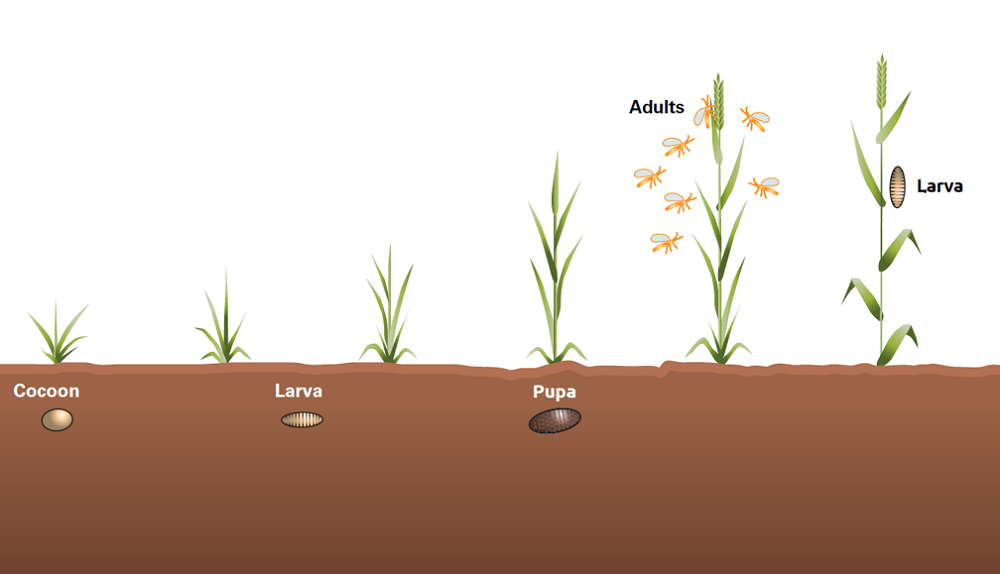- Home
- Knowledge library
- How to manage orange wheat blossom midge
How to manage orange wheat blossom midge
Once orange wheat blossom midge larvae reach the ear, sprays are no longer effective. For susceptible cereal varieties, monitoring adult midge activity is a key component of integrated pest management (IPM), with the spray-threshold system built around the number of midges observed.
How to identify wheat blossom midges
Cultural control options to suppress midge risks
Wheat and rye are particularly susceptible to orange wheat blossom midge, although barley, oats and triticale may also be affected. By following IPM approaches, risk reduction is easily achievable – with varietal resistance and natural enemies particularly important.
Varietal resistance and midge control
The AHDB Recommended List (RL) tables show the ‘believed’ (i.e. not verified in the trials) resistance status of wheat varieties. Following attack, the formation of wound plugs in resistant varieties helps prevent larval feeding. The resistance mechanism is so effective that resistant varieties do not require monitoring or insecticide treatment. Resistant varieties are, however, susceptible to yellow wheat blossom midge, although this species is less common.
Natural enemies and midge control
Several insect groups help regulate midge numbers. All harmed by insecticide applications, it is important to avoid the use of chemicals, where possible.
- The parasitic wasp species Macroglens penetrans and Platygaster tuberosula lay eggs within midge eggs. When pest larvae hatch, so do the wasp larvae, which feed on the midge larvae. With parasitism up to 80%, wasps are an important natural enemy
- Dance flies Platypalpus spp. feed on adult midges during flight. When present in large numbers, they can significantly reduce midge populations
- Ground beetlesand rove beetles eat midge larvae as they drop to the ground in late summer. If the soil is dry, larvae are unable to burrow into the ground as quickly, making them easier prey
- Spiders' webs can also trap many adult wheat blossom midges
Cultivation, rotation and midge control
Midge abundance is often highest in fields used to grow susceptible crops in the last four years. Despite this, rotation has little effect on overall risk. The impact of cultivation is also limited. Although aggressive cultivations are associated with the greatest reduction in midge numbers, they also reduce populations of natural enemies. Pest burial may also lead to longer pest emergence periods. Straw residues are also associated with reduced midge incidence.
Midge monitoring and chemical control
Once larvae have moved down into the ear, sprays are no longer effective. As a result, it is important to monitor susceptible crops for adult midges shortly before and during ear emergence. Give priority to milling crops, seed crops and sheltered feed crops. Extend monitoring to any nearby fields with a recent history of this pest. Use trap data to guide visual crop inspections and the need to treat.
Pheromone traps
Pheromone traps provide the earliest and most reliable warning of midge activity.
- Stake traps at crop height when the flag leaf sheath is swollen
- Place at least two traps in each field
- Make sure traps cover discrete blocks, to represent the various soil types, rotations, rainfall levels and soil temperatures
- Check traps daily, until the start of flowering
30–120 midges caught per trap per day = general risk to crops in the following week. Use the visual crop inspection method to detect females.
Over 120 midges caught per trap per day = high risk to crops. Treat susceptible wheat crops at growth stages 53–59 as soon as possible.
Yellow sticky traps
Yellow traps provide a good indication of midge activity. However, these catch both sexes and many other insects, so correct identification is essential.
- Hang sticky traps at crop height during ear emergence
- Place at least two traps in each field
- Check traps daily during ear emergence
Around 10 midges caught per trap per day = increased risk. Use the visual crop inspection method to detect females.
Visual crop inspection
The level of midge activity observed during visual crop inspections indicates the requirement to treat.
- Inspect susceptible crops during ear emergence from mid-evening (as light levels fall)
- Examine up to 100 ears, about 30 metres into the field
If parting the crop results in a cloud of midges, consider treating immediately.
For feed crops, the treatment threshold is one midge for every three ears.
For milling and seed crops, the treatment threshold is one midge for every six ears.
 AHDB
AHDB
Life cycle of orange wheat blossom midges.

